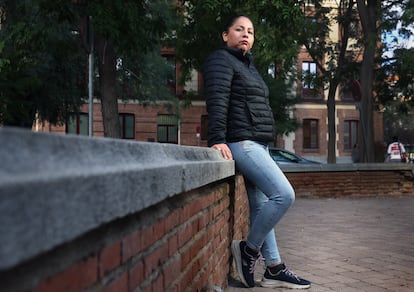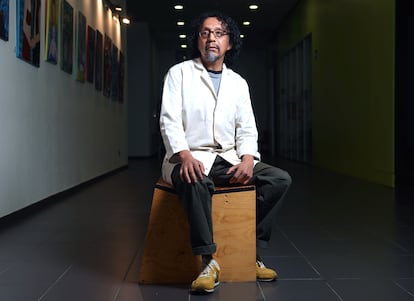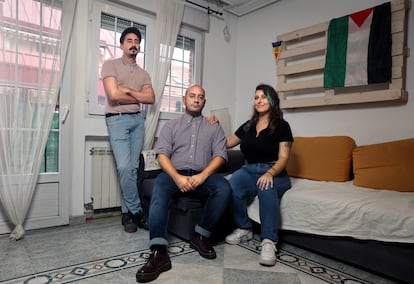In August 2018, the real estate portal Idealista hung a sign from a block of flats in Madrid that has since been seen daily by hundreds of thousands of drivers traveling in the north of the capital’s most famous ring road: “There is more life.” beyond the M-30″. When this message appeared, it could be understood as an invitation to explore the real estate market beyond the central area, where prices were already excessive for an average Madrid family. The fact is that the cartel is still there in 2024, but things have changed substantially. In these years, rent has risen 23% throughout the city and has skyrocketed outside this ring road. Several neighborhoods in the Carabanchel or Puente de Vallecas districts have registered increases of over 30%. Canillejas, in San Blas, or the Butarque neighborhood, in Villaverde, 40%.
This increase in cost is disrupting the perception that many had of these peripheral areas. As a real estate agent recently told EL PAÍS, “Carabanchel used to be the outskirts, now it is in the center of Madrid.” The prices expel families with two jobs and children from this second ring. One of the residents of Carabanchel who does not rule out crossing the M-40 towards a municipality in the metropolitan area is Vinicius Silva, a salesperson for a food company. In November he will be a father for the third time. His wife, a journalist, and he need a larger apartment. “We didn’t find anything, nothing, nothing for less than 1,000 euros!” says Silva. “Now living in Madrid is a luxury.”
These neighborhoods are no longer affordable for middle class families. An analysis by EL PAÍS with the offer prices in Idealista between 2019 and 2024 shows that five years ago, a Madrid family with a medium income (about 34,000 euros net annually) could rent a 70-meter apartment with an average price in 38 neighborhoods of 115 for which there is reliable data in the capital without making an extra effort – allocating more than 30% of their income. All of these neighborhoods were outside the M-30. Now, even though that family’s income has grown (41,000 euros), nine neighborhoods have disappeared from that list.

Neighborhoods like Canillejas, in the east of the city, not far from the Barajas airport and the new Atlético de Madrid stadium, the Metropolitano, are no longer affordable; Almendrales, in Usera, an area that is rapidly gentrifying between Madrid Río and the new Chinatown; o Vista Alegre, in Carabanchel, the district full of art galleries that last year was praised by the magazine Time Out as “the third best neighborhood in the world.”
This panorama is worse for families who rented in these neighborhoods, traditionally more humble, whose incomes are usually lower than those of a medium-sized family. These tenants already allocated more than 30% of their income in 2019, a figure that in neighborhoods such as Almendrales, Puerta del Ángel, Numancia or Pradolongo already exceeds 40% for those same families.
But perhaps the families who lived there in 2019 are not the same now. The greater effort to pay rent throughout the city may have expelled residents from central neighborhoods who have arrived in these peripheral neighborhoods, in turn sending further away the families who lived there five years ago and now cannot cope. rents, like a domino effect.
The unrest over the housing problem in Madrid was felt in the streets in the middle of this month, when thousands of young people protested in one of the largest demonstrations over this issue in recent years. Immigrants, who were less visible in that march, are also affected. Madrid is experiencing a migratory explosion that in 2023 meant a record growth of more than 120,560 residents.
Meanwhile, others see these increases as good news. The representative of Mayor José Luis Martínez Almeida in Carabanchel, Carlos Izquierdo, has celebrated the price increases on X (formerly Twitter): “Without a doubt, Carabanchel is an increasingly attractive district to live in.”
Big investors call these processes “urban regeneration.” Critics use the term “gentrification.” Wyn Williamson, a businessman who controls 300 apartments in Puerta del Ángel, on the outer limit of the M-30, recently explained it as a natural mechanism: “This is how cities work.”
An urban planner who has studied these processes in Madrid, Álvaro Ardura, says that if there is no regulatory intervention, with measures such as price caps, the less well-off Madrid residents will be expelled, as happens in other large cities. Although Madrid is different. “Gentrification has been slower here because property is less concentrated than, for example, in London,” he explains. “For this reason, in Lavapiés or Tetuán (both within the M-30) this process has not been completed.”
The despair of humble people
A tour of these neighborhoods gives an idea of the chaos suffered by Madrid residents with fewer resources due to this housing crisis: families with children and, sometimes, grandparents in a single room; shops, bars or mechanical workshops converted into housing; and fear, very fear of receiving a message from the landlord with a cursed phrase: “You are paying too little.”
Peruvian Evelyn Morín spent her first months in Madrid in a room she shared with her husband, her mother and her two children last fall. They paid 700 euros. Fourteen people lived in the property, sharing a single bathroom and a kitchen. The living room was also occupied by another tenant. They searched for a complete apartment for months without luck. The landlords slammed the door because they fear families with children. This is a consequence of protections against eviction for vulnerable groups, according to real estate agents.
Finally they were lucky and an elderly landlady, whom Morín takes care of, rented them her apartment for 800 euros in the Pan Bendito neighborhood, in Carabanchel, a very humble neighborhood. For Morín and his family, this is a step forward in their immigration project: “It is not the area one expects, but at least I can now sleep peacefully.”

The anguish of immigrants is felt in a real estate office in Canillejas, Inmogroup, every time they upload a rental advertisement to online portals. Employee Geyleen Baladi, of Venezuelan origin, is overwhelmed to answer the phone and email. A few days ago, he received 170 requests in a matter of 24 hours for a small 50-square-meter apartment. You know the figure because you must deliver a written report to the landlord, so that he can verify that they have made an exhaustive selection. Baladi crosses out those who do not comply with the requirements in red. About 90%.
His partner, Rafael Muñoz, is a 28-year veteran in the area. He says rental supply has plummeted since the state Housing Law went into effect. Although the price cap does not apply in Madrid, real estate agencies are prohibited from charging fees to tenants. It must be the landlord who pays them and that is why many now avoid the work of these offices. Others, for fear of non-payments, have taken their apartment off the market, explains Muñoz. This makes tenants accept living in substandard housing: “People are so desperate that they get into any hole.”
Anyone can see that desperation in Facebook groups. He group Latinos in Madrid. Rental of apartments and rooms It was created four years ago and is followed by more than 100,700 users. Your wall has frenetic activity. They are messages of this type: “Someone who can help a girl who only has a part-time job and is having a hard time sleeping, someone who has a small room for €250 would be very grateful, I don’t want them to start with bad comments.” , that’s what she can pay.”
Marco Valencia, a painting teacher, rents a place where he sleeps and works, in the Opañel neighborhood of Carabanchel. His landlady recently informed him of an increase, from 640 to 740 euros. “He told me that, since everything is expensive and you are paying a bargain, I have to raise you.” He, who arrived from Ecuador to the Spanish capital 22 years ago, cannot explain “this madness.” “With low salaries and high rents you can’t save,” he laments. “You live in constant poverty.”

Several cheap areas are majority immigrant territory. San Cristóbal, a southern neighborhood with the lowest income in Madrid, those born outside of Spain are already 60% of those registered. José Manuel Camacho is a 35-year-old Cuban doctor who works as a nurse for 1,200 euros because he has not been able to validate his foreign degree. He rents an apartment here with his wife and their baby, the first they have been able to afford after moving from room to room around the city. “We have visited other areas, but this is what we can afford.”
Part of the problem comes from the diversion of the real estate stock to the very lucrative market of tourist apartments. Neighborhoods on the external border of the M-30 notice this boom. In Numancia, Puente de Vallecas district, large investors have acquired entire buildings for this purpose. In just three Metro stops, tourists arrive in Atocha. In Almendrales, its proximity to the center and the Chinatown has transformed the neighborhood. “Seven years ago there were hardly any Spaniards watching the Chinese New Year parade,” says a neighbor, Fidel Oliván. “Now they are the majority.” He attributes this touristification to an interested promotion by the City Council that, at the beginning of the year, announced a million-dollar Chinatown project, with arches included, inspired by a previous one by Mayor Manuela Carmena. This phenomenon is skyrocketing prices.
Oliván and some roommates rent for 1,000 euros. They say it is little, thanks to the fact that they have extended a contract from 2017, when this area of Usera was “very cheap.” The neighbors who are arriving now have a very different profile. They are tourists and students. “Today people with infinitely worse apartments are paying 1,200, 1,400… It’s outrageous.”

Methodology
The data on the evolution of rental prices comes from the Idealista real estate portal, which collects the offer prices each month. These amounts could vary in subsequent negotiations between tenants and future tenants, but they are the best updated photo.
In the graphics of the piece, 2019 and 2024 are considered time references. For 2019, the first data for each neighborhood was taken between November of that year and February 2020, before the pandemic. By 2024, the latest data after May of this year. Neighborhoods with * do not have data that meets these requirements and we have taken the oldest and most recent value.
The income data by neighborhoods have been estimated in three steps.
- Based on the geographies of Madrid City Council neighborhoods and census sections (INE), we have assigned each section its reference neighborhood.
- To calculate the income of the neighborhood we have averaged the income of its sections (INE Home Income Atlas) weighted by the number of main homes in each section.
- As the last update is from 2022, we have raised the income of each neighborhood taking into account how the median income of households in the Community of Madrid has changed between 2022 and 2023, the latest update of the INE Living Conditions Survey.

